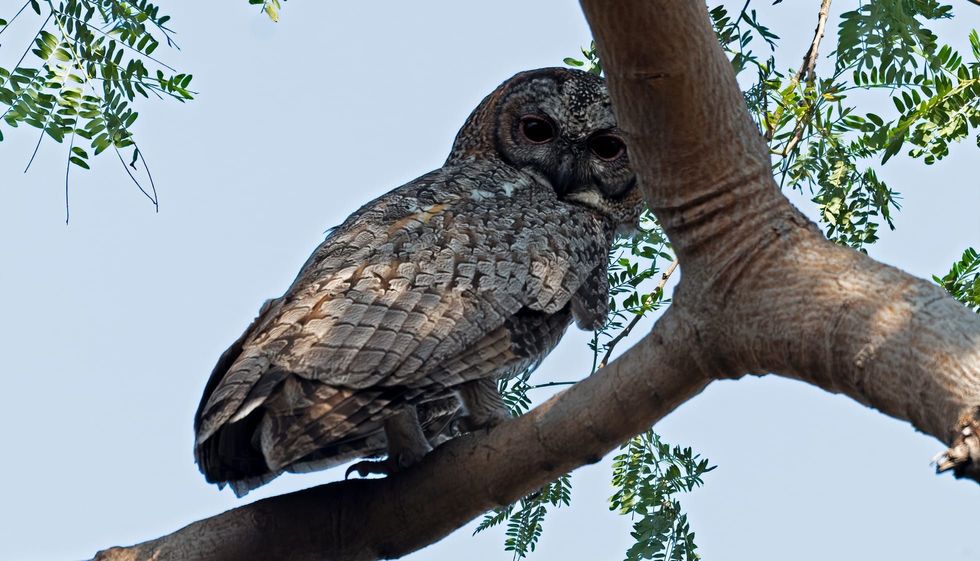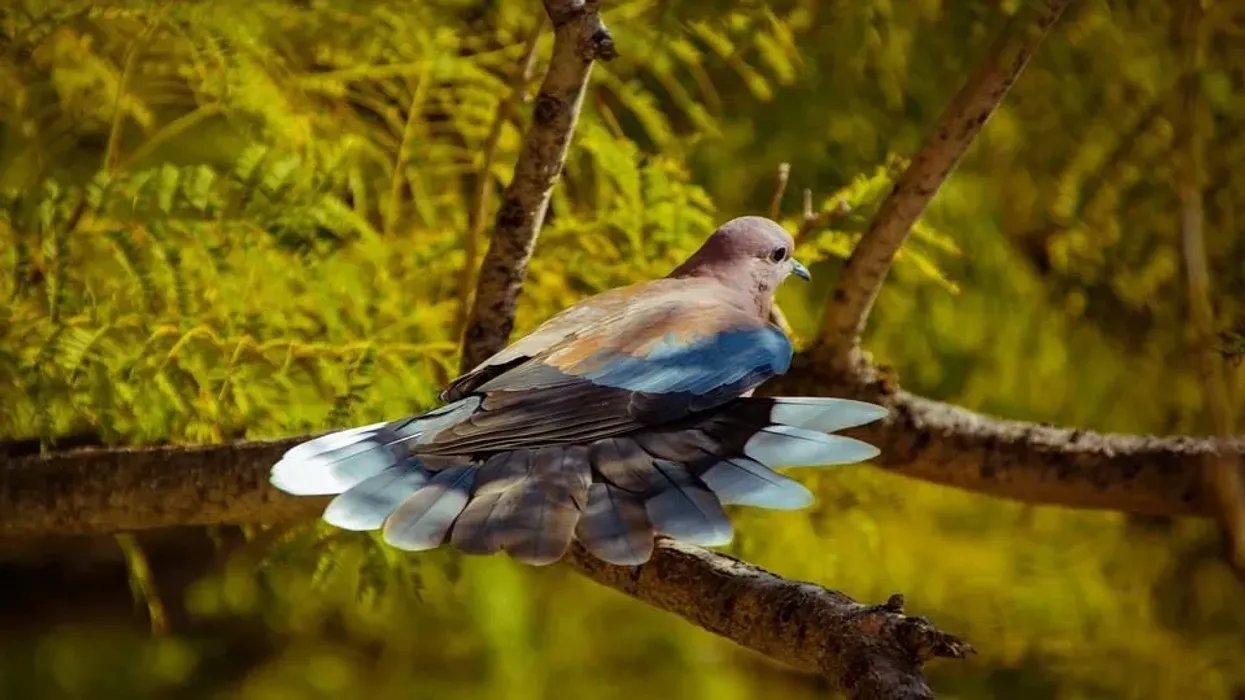The mottled wood owl (Strix ocellata) is a bird that belongs to the order of Strigiformes. The distribution of the population of this species has been observed in wooded plains, open woodland, in between and around groves of mature trees, gardens, villages, and cultivated lands.
The primary mottled wood owl location is India and the Himalayas. This species of owl is monogamous during the breeding season, meaning they find a partner bird and stay with them during the breeding season.
These owls build a nest in natural hollows and holes of trees and stumps where they lay eggs. The female owl is slightly bigger than the male. They are nocturnal birds and rest during the day.
They are usually found living in pairs or in small family groups. These birds belong to the order of Strigiformes and Strix genus
Read on to discover more fun facts about the Strix ocellata! For more relatable content, check out these mountain chickadee facts and flammulated owl facts for kids.
Mottled Wood Owl Interesting Facts
What type of animal is a mottled wood owl?
The mottled wood owl, Strix ocellata (Lesson, 1839), is a bird that belongs to the order of Strigiformes.
What class of animal does a mottled wood owl belong to?
The mottled wood owl (Strix ocellata) belongs to the class of Aves and the family of Strigidae.
How many mottled wood owls are there in the world?
The population size and range of the Strix ocellata (Lesson, 1839) have not yet been quantified as these owls are found in abundance. This species has an extremely large and wide range which is why their conservation status is of Least Concern and does not approach the thresholds for Vulnerable.
However, a steady decline in the population of these birds has been observed over the past decade.
Where does a mottled wood owl live?
The distribution of the population of this species has been observed in wooded plains, open woodland, in between and around groves of mature trees, gardens, villages, and cultivated lands. The primary mottled wood owl location is India and the Himalayas.
What is a mottled wood owl's habitat?
The mottled wood owl habitat comprises wooded plains, open woodland, in between and around groves of mature trees, gardens, villages, garden trees, and cultivated land. This bird can not be found in all parts of the world.
The mottled wood owl range map starts in India extends all the way up to the Himalayas. The distribution of this species is very restricted. They are nocturnal in nature, meaning they are active only before dawn when it is dark outside.
These birds are ideally found in pairs but may also be found in groups at times. These owls have three other subspecies that closely resemble this owl.
Who do mottled wood owls live with?
The wood owl (Strix ocellata) lives either in pairs of two or in a group of six to eight.
How long does a mottled wood owl live?
Data regarding the exact lifespan of this species is not yet known. However, this owl species usually lives up to 10 years or more if they don’t contract any disease and are able to live in their natural habitat.
How do they reproduce?
The breeding season of the mottled wood owl species starts in November and ends by April in the peninsular regions of India. The mottled wood owl egg-laying season is during February and March in northern India.
This species of owl are monogamous during the breeding season, meaning they find a partner bird and stay with them during the breeding season. These owls build a nest in natural hollows and holes of trees and stumps where they lay eggs.
The nest is typically not lined or precise. In some very rare cases, during the breeding season, these birds have been observed to nest in abandoned stick nests of other birds.
The female wood owl typically lays a clutch containing two or three soft white ovoid eggs. The female owl incubates the eggs for about 30-32 days.
What is their conservation status?
The global population range of the mottled wood owl (Strix ocellata) has not been quantified or stated in terms of exact numbers. However, the overall population range of this owl species in India is reported to be stable and abundant and not rare.
Habitat destruction and pet trade are the main threats that may endanger the survival of these owl species over time.
Mottled Wood Owl Fun Facts
What do mottled wood owls look like?
The Strix ocellata is a mid-sized owl, measuring 16.1-18.9 in (41-48 cm) in length. The mottled wood owl wingspan length is between 12.6-14.6 in (320-372 mm). Both sexes of this species look alike and it is very difficult to tell them apart if not for their size.
The female owl is slightly bigger than the male. They are nocturnal birds and rest during the day. They are usually found living in pairs or in small family groups.
These birds belong to the order of Strigiformes and Strix genus. The description of this bird is very similar to the description of the Strigidae.
These mottled wood owls have very unique features. They have a very well-developed facial disc that is marked equally above and below the eyes. Its eyes are outlined with a bright red color.
The facial disc is white in color with concentric, sharp, fine, black barring and random patterns of orange mottling. They lack tufts. These distinctive features make the identification procedure of this species easier.
The upper half of the mottled wood owl species are grayish with brown and gray mottling. The chin is whitish and round. The size of this owl's eyes is quite large in comparison to the size of its body.

How cute are they?
These birds are anything but cute and they have scary red eyes that can frighten anyone. Their unusual hooting and calls during the night in the dark often remind people of a haunted situation, making this bird a very unappealing one. One thing that makes birds attractive is their song but this bird does not even sing.
How do they communicate?
This species uses loud calls to communicate. The mottled wood owl call is typically a loud, quavering, eerie 'chuhua-aa' sound.
These calls are spine-chilling and last for around two seconds in order to communicate with the other owls. These calls make the identification process easier as the mottled wood owl sound is so loud that anyone can recognize the species.
How big is a mottled wood owl?
This species is 16.1-18.9 in (41-48 cm) long and it is half the size of a red owl.
How fast can a mottled wood owl fly?
There are no records or reliable information about the flying speeds of this species. However, they can be seen flying at a moderate pace and they increase their speed when they see food close by.
How much does a mottled wood owl weigh?
This species weighs 1.6 lb (720 g) and it is quite lightweight considering its size.
What are the male and female names of the species?
There is no specific name given to Strix ocellata owls based on their sex. The males are referred to as male owls while the females are referred to as female owls.
What would you call a baby mottled wood owl?
The mottled wood owl baby is called an owlet.
What do they eat?
The mottled wood owl diet consists of Indian palm squirrels, mice, and other small rats, small birds, crabs, lizards, and large insects.
Are they dangerous?
Strix ocellata owls are a reclusive species and therefore not much information is available about their behavioral patterns. They do not seem like they can harm humans.
Would they make a good pet?
They do not make good pets as they are very reclusive creatures. They are quite scary looking, up close, and can scare away humans. They have large crimson-orange eyes that can be quite frightening to look at. They can not see during the day or in bright light.
Did you know...
The subspecies of this species, the S. o. ocellata is distributed in regions of peninsular India. The subspecies S. o. grandis is distributed in the states of Gujarat, parts of Maharashtra, and parts of Rajasthan. Mottled wood owl calls are feared in the south-Indian state Kerala and are called 'Kalan kozhi' which means 'fowl of death'.
The mottled wood owl wingspan is quite large and ranges between 12.6-14.6 in (320-372 mm).
The mottled wood owl range map is exclusive to India. These owls prefer to live in wooded areas and have a mottled appearance which has influenced their name.
Do mottled wood owls migrate?
There is not much information about the migration pattern of this species. However, it is assumed this species does not migrate. This owl prefers to stay in its region of origin throughout the year. These birds usually prefer to stay in the same region as their breeding grounds.
What is unique about mottled wood owls?
This species is endemic to India and the Himalayas and can not be found anywhere else in the world which is why they are highly demanded in the animal trade.
Here at Kidadl, we have carefully created lots of interesting family-friendly animal facts for everyone to discover! Learn more about some other birds from our rufous owl fun facts and burrowing owl interesting facts pages.
You can even occupy yourself at home by coloring in one of our free printable geometric owl coloring pages.
Thank you to Kidadler Abhay Chaware for providing the image of the Mottled Wood Owl in this article.









